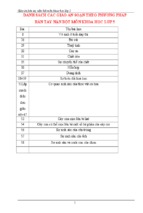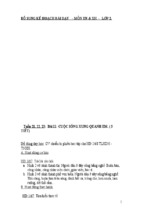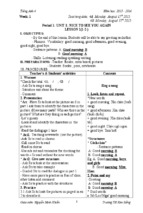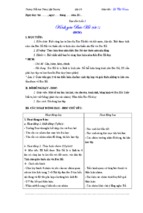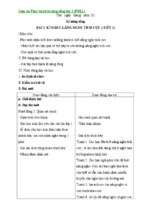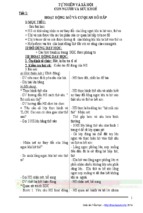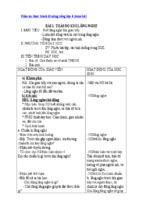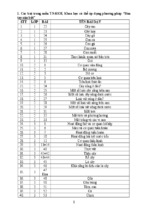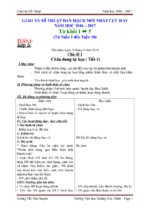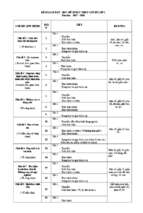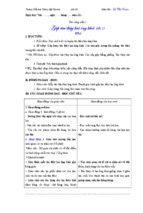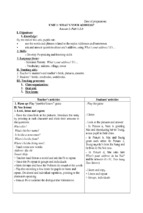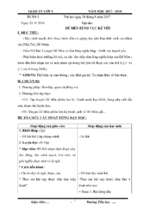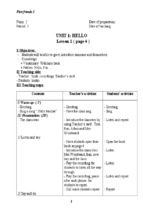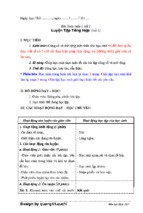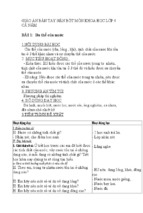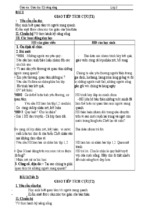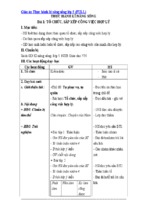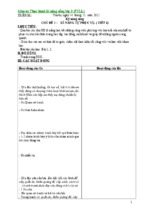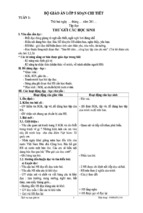Week: 01
Period: 02
Date of preparation: ………………..
UNIT 1:
GREETINGS
Lesson 1:
HELLO (A1 – A4 )
I. Aim: To teach students “ Hi / Hello” , “ I’m … / My name’s…” to introduce themselves and numbers 0 – 5.
II. Objective: By the end of the lesson, students may introduce themselves.
III. Teaching aids: Pictures and cards
IV. Procedure:
Time
3’
10’
Content
Teacher’s activities
1.Revision:
- Should we learn vocabulary?
- How can you learn vocabulary?
-Ask students some questions about -Answer
how to study English.
questions
2.Presentation:
+Vocabulary:
- Hi / Hello: Chaøo
- a name: teân
- I : toâi
- My: cuûa toâi
- Am / is / are: laø
Elicit vocabulary
Situation
Explanation
Mine
Translation
Translation
+ Checking vocabulary:
Rub out and remember
- Point to the Vietnamese
translation and ask “ What’s this
in English?”
- If there is time, get students to
write the English words again.
+ Target language:
Form:
- Hello / Hi.
- I am ( ‘m )... / My name is (‘s) …
- Xin chaøo.
- Toâi laø… / Teân cuûa toâi laø…
- Duøng khi chaøo (thaân maät) vaø töï
giôùi thieäu.
10’
Students’ activities
Pictures
- Use pictures to set the scene in
an effort to elicit the target
structures.
- Ask students to say the
greetings how to introduce
themselves.
3. Practice: A3,4 (page 11)
- I’ am Lan.
- I’ am Nga.
- My name is Ba.
- My name is Nam.
Picture cues
- Run through the pictures .
- Let students play the role of
Lan, Ba, Nga and Ba.
- Listen to them and correct their
the
teacher’s
- Listen to the teacher.
- Give the meaning of the
words.
- Repeat after the teacher.
- Copy down.
- Look at the Vietnames
translation and call the
English words.
- Come to the board and
rewrite them in English.
- Pay attention to what the
teacher shows and listen to
him or her attentively.
- Say the greeting and how to
identify oneself.
- Look at the pictures.
- Follow the teacher.
- Practice individualy
pairs, in groups.
page 1
in
mistakes If they don’t pronounce
correctly.
5’
Numbers:
- Oh: 0
- One: 1
- Two: 2
- Three: 3
- Four: 4
- Five: 5
Mine
//
- Notice the main
Hello (2nd syllable).
tress
- Look at the teacher.
- Listen.
- Repeat individually.
Copy the number in
notebooks
the
Translation
+ Checking vocabulary:
1
4
3
5
2
7’
Practice:
- Can Tho 071
- Quang Ninh
- Ha Noi 04
7’
4.Further practice:
3’
5.Homework:
- Numbers 0 -5
- Hello / Hi / I’m.. / My name is …
- Unit1: Greetings – Lesson 2 (A5A8 ).
- Tra Vinh 074
- Hue 054
- Da Nang 051
Slap the board
- Put the numbers on over the
board
- Call two students or two teams
of students to the front of the
class.
- Call out one of the numbers in
English in loud voice.
Group works.
- Say the numbers .
- Listen to the numbers.
- Run forward and slap the
correct numbers on the board.
Word cues
- Run through the cues.
- Model first.
- Example: S1: Can Tho, please.
S2: Oh – seven –
one.
Work in pairs
- Repeat it chorally and then
individually.
- Make the sentence for
themselves.
- Let them follow the model, then
use their own names.
- follow the teacher, then use
the own names.
- Ask students to learn how to - Take notes.
greet people, to identify oneself - Do as the teacher requests.
nnmbers 0 – 5 and prepare Lesson
2 ( A5-A8) “Ask how people are
and say thank you”.
.............................................................................................................................................................
……………………………………………………………………………………………………………………………………………………………..
……………………………………………………………………………………………………………………………………………………………..
……………………………………………………………………………………………………………………………………………………………..
……………………………………………………………………………………………………………………………………………………………..
……………………………………………………………………………………………………………………………………………………………..
……………………………………………………………………………………………………………………………………………………………..
……………………………………………………………………………………………………………………………………………………………..
……………………………………………………………………………………………………………………………………………………………..
……………………………………………………………………………………………………………………………………………………………..
page 2
Week: 01
Period: 03
Date of preparation:……………….
UNIT 1:
GREETINGS
Lesson 2:
HELLO (A5 – A8 )
I. Aim: Help students ask how people are, say thank you and numbers 0 – 10.
II. Objective: By the end of the lesson, students will be able to use “How are you” and “ I’m fine thank you” to
ask how people are and say thank you.
III. Teaching aids:
III. Procedure:
Time
5’
10’
Content
1.Revision:
- wto
=
- etrhe
=
- ifve
=
- eno
=
- roze
=
two
three
five
one
zero
2.Presentation:
+Vocabulary:
- Fine (adj): toát, khoûe
- Thanks: caûm ôn
- Miss : coâ (vôùi teân)
- Mr: oâng (vôùi teân)
+ Checking vocabulary:
5’
+ Target language:
Ba: Hi, Lan.
Lan: Hello, Ba.
Ba: How are you?
Lan: I’m fine thank you. And you?
Ba: Fine, thank.
- How are you?
- I’m fine. Thanks/ Thank you.
- Baïn coù khoûe khoâng?
- Toâi khoûe. Caûm ôn.
-Duøng ñeå hoûi thaêm söùc khoûe vaø
Teacher’s activities
Jumbled words
-Write numbers whose letters are
in disorder.
- Divide the class into two
teams.
- Ask students from each team to
go to the board and write the
correct words .
Elicit vocabulary
Situation
Situation
Translation
Translation
Rub out and remember
-Point
to
the
Vietnamese
translations and rub out English
words.
- Get students to call the English
words.
Students’ activities
-Look at the board.
- Listen to the teacher.
- Work in teams.
- Go to the board and write
the correct words. (One word,
one student)
- Listen to the teacher.
- Give the meaning of the
words.
- Repeat after the teacher.
- Copy down.
- Students repeat chorally
and remember all the English
words.
- Call the English words and
write the English words if
there is time.
- Pay attention to what the
Presentation dialogue.
- Ask students to listen to teacher shows and listen to
the tape.
between Ba and Lan.
- Answer the questions.
- Who are they?
- They are Ba and Lan.
- What does Ba ask? And Lan?
- How are you? – I’m fine.
- How can you say them in
Thanks.
Vietnamese?
- Ask how people are and say
- What do you use them for?
thanks.
- Write in the notebooks.
page 3
noùi lôøi caûm ôn.
15’
5’
7’
3’
3. Practice:
Ba: Hi, Lan.
Lan: Hello, Ba.
Ba: How are you?
Lan: I’m fine thank you. And you?
Ba: Fine, thanks.
Substitution drill
- Get students to repeat the
dialogue.
- Call out the underlined words to
be changed in the dialogue.
- Listen to them and correct their
mistakes If they don’t pronounce
correctly.
Numbers: 6 - 10
- Six
- Seven
- Eight
- Nine
- Ten
Matching
- Write the words in a list and the
numbers in wrong order.
- Get students to come to the
board to match the words with the
numbers.
- Correct.
9
7
10
6
8
- Look at the pictures.
- Repeat after the teacher.
- Make the change and
repeat the new dialogue.
- Pracitce in pairs, use the
name of the people in the
pictures.
- Listen to the teacher.
- Go to the board to match
the
words
with
the
numbers.Listen.
- Read the numbers.
- Copy the number in the
notebooks
4.Further practice:
8200294
8504423
9565656
708279
Dictation
- Show students the telephone
numbers.
- Ask students what they are.
- Read the telephone numbers.
5.Homework:
- Numbers 0 -10
- How are you? – I’m fine. Thanks.
And you?
- Some homework in the workbook
from page 3 to page 4.
- Unit1: Greetings – Lesson 3 (B1B6 ).
- Ask students to learn how to ask - Write the dialogue ( A7 ).
how people are, say thank you, - Do homework as directed.
numbers 0 –10.
- Have them do homework and
prepare Lesson 3 ( B1-B6):How
to greet people (in the morning,
……) to say goodbye .
- Look at the number and
answer.
- Telephone numbers.
- Listen to the teacher and
write
.............................................................................................................................................................
……………………………………………………………………………………………………………………………………………………………..
……………………………………………………………………………………………………………………………………………………………..
……………………………………………………………………………………………………………………………………………………………..
……………………………………………………………………………………………………………………………………………………………..
……………………………………………………………………………………………………………………………………………………………..
……………………………………………………………………………………………………………………………………………………………..
……………………………………………………………………………………………………………………………………………………………..
page 4
Week: 02
Period: 04
Date of preparation:……………..
UNIT 1:
Lesson 3:
GREETINGS
GOOD MORNING (B1 – B6 )
I. Aim: Help students to learn how to greet people (in the morning, in the afternoon, in the evening) to say
goodbye, to count from 11 to 15.
II. Objective: By the end of the lesson, students will be able to use the expressions above to greet people and to
say goodbye.
III. Teaching aids: Poster and pictures
IV. Procedure:
Time
5’
Content
Teacher’s activities
1.Revision:
7
6
2
1
3
10’
2
8
5
10
9
Bingo
-Put the numbers on the board.
-Ask students to choose any five
numbers and copy them into their
books.
- Read out the numbers in any
order.
Elicit vocabulary
- Say the greetings and have
students repeat.
- Emphasize the main stress in the
greetings.
Ask
students
to
say
translations.
+ Checking vocabulary:
Good afternoon
Good morning
Good evening
Good evening
Good night
Goodbye
5’
2.Presentation:
+Vocabulary:
- Good morning: chaøo (buoåi saùng) Good afternoon: chaøo(buoåi chieàu)
- Good evening: chaøo (buoåi toái)
- Good night: chuùc nguû ngon
- Goodbye: taïm bieät
- Children: nhöõng ñöùa treû.
What and where
- Elicit the vocabulary from the
students and write them in the
circles.
- Get students to repeat the
words including the rubbed out
words by pointing at the empty
circle.
+ Target language:
Miss Hoa: Good morning, children.
Children: Good morning, Miss Hoa
Miss Hoa: How are you?
Children: We’re fine, thank you.
How are you ?
Miss Hoa: Fine, thank. Goodbye.
Rub out and remember
dialogue.
- Put the dialogue on the board
-Set the scene to introduce the
greetings.
- Who are they?
- What are they doing?
Students’ activities
-Look at the board.
- Listen to the teacher.
- Choose any five numbers.
- Put ticks next to the
numbers that the teacher
reads.
- Shouts “Bingo”.
- Listen to the teacher.
- Repeat.
- Notice the main stress
pattern.
- Copy the new words in the
notebooks .
- Students repeat chorally
and remember all the words.
- Go to the board and fill in
the circles with the right
words.
- Pay attention to the
teacher and answer the
questions.
- They are Miss Hoa and
children.
They
are greeting
page 5
- Read the dialogue and rub out
Children: Bye.
some of the words.
- Good morning.
- Rub out all of the words.
- We’re fine. Thank you.
- Goodbye / Bye.
- Ask student some questions.
- Chaøo
- How does Miss Hoa greet the
children?
What
about
the
- Chuùng toâi / em khoûe. Caûm ôn.
children?
-Duøng ñeå chaøo hoûi mang tính trang
troïng, lòch söï vaø phaân bieät thôøi ñieåm - What does Miss Hoa do?
trong ngaøy.
- What do the children do?
- What do they say at the end?
10’
3’
2’
7’
3’
together.
- Practice saying it and have
to remember the rubbed out
words
- Repeat the rubbed out
dialogue from memory.
- Good morning, children.
- Good morning, Miss Hoa.
- She is a teacher.
- They are students.
- Goodbye – Bye.
3. Practice: B2 (page 15)
- Good morning
- Good afternoon
- Good evening
- Good night
Picture drill
- Run through the pictures.
- Let students identify the
differences between the pictures.
- When is the first /……… picture?
- How can you greet people in the
morning?
- Ask them to practice in pairs
and in groups.
- Correct if there are any
mistakes.
Numbers: 11 - 15
- Eleven = 11
- Twelve = 12
- Thirteen =
13
- Fourteen = 14
- Fifteen = 15
+ Checking vocabulary:
Elicit vocabulary
Translation
//
//
//
//
Guess the numbers
- Get students to come to the
front think of one of the numbers .
- Get the rest of the class to guess
which number it is.
4.Further practice:
B6 (page 16)
Writing
- Ask students to complete the
dialogue.
- Ask students to play the role of
Lan and Nga.
5.Homework:
- Numbers 11 -15
- Good morning /afternoon / …………
- Goodbye / Bye.
- Unit1: Greetings – Lesson 4 (C1 –
C4 ).
- Ask students to learn how to - Memorize the greetings
greet people, say goodbye, and numbers 0 – 15.
numbers 11–15.
- Do homework as directed.
- Have them prepare Lesson 4
( C1-C4):How to talk about age
“How old are you?” and to count
from 16 to 20
- Look at the pictures.
- Repeat after the teacher.
- Answer the questions.
In
the
morning/
afternoon …
- Good morning.
- Pracitce greeting and
saying goodbye in pairs then in
groups.
- Some students practice in
front.
- Listen to the teacher.
- Say the words in English.
- Read the new words.
- Write the new words
in
their notebooks.
- Think of any numbers.
- Guess which number is by
asking the question: Is it
………… ?
- Answer: Yes / No.
- Work individually
- Share their answers.
- Work in pairs.
page 6
Week: 02
Period: 05
Date of preparation:……………….
UNIT 1:
Lesson 4:
GREETINGS
HOW OLD ARE YOU? (C1 – C4 )
I. Aim: “How are you” to talk about age and numbers 16 – 20.
II. Objective: At the end, students will be able to say how old one is, to ask how old others are and to count
from 16 to 20.
III. Teaching aids: Pictures and poster
IV. Procedure:
Time
5’
10’
Content
1.Revision:
- Good morning
- Good afternoon
- Good evening
2.Presentation:
+Vocabulary:
- Sixteen
- Seventeen
- Eighteen
- Nineteen
- Twenty
Teacher’s activities
- Good night
- Goodbye
=
=
=
=
=
16
17
18
19
20
+ Checking vocabulary:
19
16
17
20
18
5’
15’
+ Target language:
- C3 (page 18)
- How old are you?
- I’m (am) ……… years old.
- Baïn bao nhieâu tuoåi?
- Toâi ……………… tuoåi.
- Hoûi tuoåi ngöôøi khaùc vaø traû lôøi.
3. Practice:
Nam: Hi, Ba.
Students’ activities
- Call two students to the front of
the class and say the greetings.
- Read the numbers: 13, 15, 11,
12,.
- Say the greetings and
goodbye.
- Write the numbers in
English.
- Listen to the teacher.
- Say the numbers in English
- Repeat after the teacher.
- Notice the main stress
- Write the new words in
their notebooks.
Elicit vocabulary
Picture
//
//
//
//
Slap the board
- Put the numbers on over the
board
- Call two students or two teams
of students to the front of the
class.
- Call out one of the numbers in
English in loud voice.
Group works.
- Say the numbers .
- Listen to the numbers.
- Run forward and slap the
correct numbers on the board.
Presentation dialogue.
- Set the scene in which there are
three people.
- Ask students to listen to the tape
and repeat.
+ What does Miss Hoa ask Lan?
+ What does it used for?
- Pay attention to what the
teacher shows and listen to
the tape.
- Repeat after the teacher.
- Answer the questions.
- How old are you?.
- Ask how old others are.
Substitution drill
- Get students to repeat
the - Look at the pictures.
page 7
This is Phong
Ba:
Hi, Phong.
How old are you?
Phong: I’m twelve.
7’
3’
dialogue.
- Call out the underlined words to
be changed in the dialogue.
- Listen to them and correct their
mistakes.
4.Further practice:
Play role
- Divide the class into small
groups of three students.
- Let them play the roles.
- Ask some students about their
ages.
5.Homework:
- Numbers 0 -20
- How old are you?
- I’m ……………… years old.
- Unit1: Greetings – Lesson 5 (C5C6 ).
- Repeat after the teacher.
- Make the change and
repeat the new dialogue.
- Pracitce in pairs, use the
name of the people in the
pictures.
- Work in small groups of
three students.
- Play the roles.
- Answer about their ages .
- Copy down the dialogue
(C3).
- Ask students to learn how to ask - Take notes.
how old people are, numbers 0 –20 - Do homework as directed.
- Have them and prepare Lesson
5 ( C5-C6):Further Practice in
Numbers 0 – 20 and telephone
numbers .
.............................................................................................................................................................
……………………………………………………………………………………………………………………………………………………………..
……………………………………………………………………………………………………………………………………………………………..
……………………………………………………………………………………………………………………………………………………………..
……………………………………………………………………………………………………………………………………………………………..
……………………………………………………………………………………………………………………………………………………………..
……………………………………………………………………………………………………………………………………………………………..
……………………………………………………………………………………………………………………………………………………………..
……………………………………………………………………………………………………………………………………………………………..
……………………………………………………………………………………………………………………………………………………………..
page 8
Week: 02
Period: 06
Date of preparation:……………….
UNIT 1:
GREETINGS
Lesson 5: HOW OLD ARE YOU (C5 – C6 )
I. Aim: Further practice in number 0 – 20 to count and give telephone numbers .
II. Objective: At the end, students will be able to use numbers fluently.
III. Teaching aids: Cards
IV. Procedure:
Time
5’
Content
1.Warm up:
7, 19, 15, 20, 6, 13, 8,
10, 1, 4, 11, 14, 2, 0,
3, 16,5, 17,12, 18,9.
10’
10’
2. Practice:
- tgieh
- trentieth
- lewtev
- ytwnet
- nternouf
- eevsn
- ientenen
=
=
=
=
=
=
=
04 821 4076
-Look at the board.
- Listen to the teacher.
- Choose any five numbers.
- Put ticks next to the
numbers that the teacher
reads.
- Shouts “Bingo”.
Jumbled words
-Write numbers whose letters are
in disorder.
- Divide the class into two
teams.
- Ask students from each team to
go to the board and write the
correct words .
-Look at the board.
- Listen to the teacher.
- Work in teams.
- Go to the board and write
the correct words. (One word,
one student).
054 845 832
Dictation and picture cue drill
- Write the numbers on the
board.
- Ask students copy any numbers in
their notebooks
- Do the modelsentences:
S1: What’s your numbers? S2:
0h-seven-eight-threenine
- Look at the board.
- Copy any numbers in their
notebooks.
- Listen to the teacher.
- Work in pairs.
- Some pairs practice in
front.
Survey
- Write the table on the board.
- Ask students some questions :
+ What is this? And this?
- Example exchange:
+ What’s your name? Hoa
+What’ your numbers?
- Look at the board.
- Answer the questions:
- Name
–
Telephone
numbers.
- Practice in pairs.
- Ask and take notes.
- Retell.
5511 82 66 99
08 557 1313
071 839 737
033 612 300
0240 853 199
3.Production:
Name
1. Hoa
2. …………
3. …………
4. …………
Bingo
- Put the numbers on the board.
-Ask students to choose any five
numbers and copy them into their
books.
- Read out the numbers in any
order.
Students’ activities
eight thirteen
twelve twenty
fourteen
seven
nineteen
091 34 33565
15’
Teacher’s activities
Telephone numbers
033 612 300
………………………
………………………
………………………
page 10
5’
4.Homework:
- Numbers 0 -20
- Exercises in the exercise book from
page 5-9.
- Unit2: Greetings – Lesson 1 (A1A4 ).
- Ask students to learn how to - Memorize the greetings.
numbers 0 –20
- Do homework as directed.
- Have them do copy down the
dialogue and the exercises in the
exercise book and prepare Unit2:
Come in – Lesson 1 (A1- A4).
.............................................................................................................................................................
……………………………………………………………………………………………………………………………………………………………..
……………………………………………………………………………………………………………………………………………………………..
……………………………………………………………………………………………………………………………………………………………..
……………………………………………………………………………………………………………………………………………………………..
……………………………………………………………………………………………………………………………………………………………..
……………………………………………………………………………………………………………………………………………………………..
……………………………………………………………………………………………………………………………………………………………..
……………………………………………………………………………………………………………………………………………………………..
……………………………………………………………………………………………………………………………………………………………..
page 11
Week: 03
Period: 07
Date of preparation:……………..
UNIT 2:
AT SCHOOL
Lesson 1:
COME IN (A1 – A4 )
I. Aim: Students learn how to use simple commands in class.
II. Objective: By the end of the lesson students will be able to understand the teacher’s Commands.
III. Teaching aids: Poster
IV. Procedure:
Time
5’
Content
Teacher’s activities
1.Warm up:
9+1
10 + 2
17 + 1
6+5
8+4
3+8
10’
13 + 7
6 + 10
Nought and crosses
- Put the grid on the board.
- Divide class into teams. One is
noughts (O) and the other is
Crosses (X).
- Two teams choose any
numbers in the boxes and say the
numbers in English.
- The team which has three
noughts or three crosses on a line
will win the game.
Students’ activities
- Look at the board.
- Work in groups.
- One is noughts (O) and the
other is Crosses (X).
- Choose any numbers in the
boxes and say the numbers in
English.
* Team A:
- Student 1: Ten and Two?
- Student 2: Twelve
5+3
2.Presentation:
+Vocabulary:
- ( to ) come in : ñi vaøo.
- ( to ) sit down : ngoài xuoáng.
- ( to ) stand up : ñöùng leân.
- ( to ) open your book : môû saùch.
- ( to) close your book: ñoùng saùch
+ Checking vocabulary:
ñöùng leân
ñi vaøo
ñoùng saùch
môû saùch
ngoài xuoáng
Elicit vocabulary
Visual
Mine
Antonym
Mime
Antonym
- Listen to the teacher.
- Say the commands in
English
- Repeat after the teacher.
- Notice the pronunciation.
- Write the new words in
their notebooks.
Slap the board
- Put the Vietnamese translation of
the new words on the board.
- Call two students of two teams
to the front of the class.
- Call out one of the commands
in English in loud voice.
Group works.
- Say the Vietnamese words
.
- Listen to the teacher.
- Run forward and slap the
correct commands on the
board.
- Continue until students
have slapped all the words.
page 12
3’
15’
+ Target language: - A1 (P. 20)
- Come in.
- Sit down / Stand up.
- Open / Close your book.
- Ñi vaøo.
- Ngoài xuoáng / Ñöùng leân.
- Môû saùch / Ñoùng saùch.
- Ra leänh cho ngöôøi khaùc .
3. Practice:
- A2 - 3 (page 21, 22)
a) Open your book.
b) Sit down.
c) Come in.
d) Close your book.
e) Stand up.
9’
4.Further practice:
Miss Hoa Children
………… morning! .. morning,M.H !
How ………………? We’re … How…?
Fine …… Sit
Yes, Miss!
And open Yes, Miss!
3’
5.Homework:
- Sit down.
- Stand up.
- Come in.
- Open your book.
- Close your book.
- Unit2: Come in – Lesson 2 (B1B2).
Presentation pictures.
- Set the scene, introduce the
commands, using pictures.
- Let students repeat after the
teacher.
+ What is the teacher doing?
+ What does she say?
+ What does it used for?
Matching
- Ask studnets to match up the
commands
with
appropriate
pictures.
Simon says
- Let them practice the
commands together.
- Let them play game: “Simon
says”
Mapped dialogue
- Put the dialogue on the board
which is only words. The words
are cues.
- Model the dialogue.
- Run through the cues like a drill
with the whole class.
- Listen to the teacher
without opening the books.
- Look at the pictures and
repeat after the teacher.
- Answer the questions.
- Come in.
- To give a command.
- Read the commandans.
- Match up the commands
with appropriate pictures.
- Practice in pairs.
- Play games.
+ S1: Simon says: Stand up.
+ S2: Stand up.
- Look at the board and
listen to the teacher.
- Repeat after the teacher.
- Practice the dialogue in
pair .
- Some pairs practice in
front.
- Ask students to learn how to use - Take notes.
simple commands in class.
- Memorize the commands.
- Have them prepare Lesson 2 - Do as the teacher requests.
( B1-B2): How to ask and answer
about names and where they live.
.............................................................................................................................................................
……………………………………………………………………………………………………………………………………………………………..
……………………………………………………………………………………………………………………………………………………………..
……………………………………………………………………………………………………………………………………………………………..
……………………………………………………………………………………………………………………………………………………………..
……………………………………………………………………………………………………………………………………………………………..
……………………………………………………………………………………………………………………………………………………………..
……………………………………………………………………………………………………………………………………………………………..
……………………………………………………………………………………………………………………………………………………………..
……………………………………………………………………………………………………………………………………………………………..
page 13
Week: 03
Period: 08
Date of preparation:……………….
UNIT 2:
AT SCHOOL
Lesson 2: WHERE DO YOU LIVE? (B1 – B2)
I. Aim: Students learn how to ask and answer about where they live.
II. Objective: By the end of the lesson, students will be able to use “ Where do you live?” questions to talk
about the places they live.
III. Teaching aids: Cards
IV. Procedure:
Time
Content
Teacher’s activities
5’
1.Warm up:
- Sit down.
- Stand up.
- Come in.
- Open your book.
- Close your book.
10’
2.Presentation:
+Vocabulary:
- ( to ) live : soáng
- ( in ) a house : (trong) caên nhaø.
- ( on ) a treet : (treân) ñöôøng phoá.
- ( in ) a city : (ôû) thaønh phoá.
Simon says
- Simon says: “Stand up”
“Sit down”
- “Open your book”
- Simon says “Open your book”
- Simon says “Close your book”
+ Checking vocabulary:
5’
live
city
street
house
Hueá
soáng
+ Target language: - B1 (Page. 23)
Mai: What’s your name?
Nam: My name’s Nam.
Mai: Where do you live?
Nam: I live on Tran Phu Street.
Mai: How old are you?
Nam: I’m twelve years old.
- Where do you live?
- I live in / on …………
Elicit vocabulary
Tranlation
Drawing
Visual
Picture
Matching
- Put the Vietnamese translation,
English words and pictures on the
board.
-Ask students to match English
words with the Vietnamese
translation and pictures.
Presentation pictures.
- Show students, places and the
conversation they have in the
pictures.
- Let them listen to the cassette.
- Let students repeat after the
teacher.
-Get students to isolate the model
Students’ activities
- Play games.
- Stand up.
- Sit down.
- X.
- Open their books.
- Close their books
- Listen to the teacher.
- Answer the T’s questions.
- Repeat after the teacher.
- Notice the main stress
pattern.
- Write the new words in
their notebooks.
Group works.
- Lookl at the board.
- Listen to the teacher.
- Work in teams.
- Come to the board and
match English words with the
Vietnamese translation and
pictures.
- Look at the pictures and
listen to the teacher’s
explanation.
- Listen to the cassette and
repeat as the teacher aked.
-Repeat after the teacher.
- Isolate the model sentence
by reading aloud the
page 14
- Baïn soáng ôû ñaâu?
- Toâi soáng ôû …………
- Hoûi nôi soáng cuûa ngöôøi khaùc.
15’
3. Practice:
a house
Haø Noäi
HCMC
Huøng Vöông St
7’
Leâ Lôïi Street
a city
4.Further practice:
Name
Lan
3’
Street
Leâ Lôïi St
City
HCMC
5.Homework:
- Vocabulary.
- Where do you live?
- I live in / on ……………
- Unit2: Where do you live?
Lesson 3 (B3-B4).
sentence.
- Ask students to pay attention to
the pronunciation, the linking
sounds:
* I live in …………….
Word cues
- Run through the words.
- Hold up the first cue and say the
model sentences.
- Do the same for the seccond
cue.
- Elicit the sentence by holding
up the cue.
- Correct their mistakes.
Survey
- Have students look at the table
on the board.
- Ask students to ask and answer
questions about their places and
fill in information .
-Correct if there are any mistakes
underlined sentence.
- Pay attention to the
pronunciation, the linking
sounds
* I live in …………….
- Look at the cues.
- Listen to the teacher.
- Repeat it chorally and then
individually.
- Make the sentence for
themselves.
- Practice in pairs.
- Some pairs practice in
front.
- Look at the board and
listen to the teacher.
- Ask and fill in information
about three others.
- Some students retell their
partners’ places.
- Ask students to learn - Take notes.
Vocabulary and how to ask and - Do as the teacher requests.
answer about Where they live.
- Have them prepare Lesson 3
( B3-B4): How to talk about
names,How to spell the alphabets
and their names .
……………………………………………………………………………………………………………………………………………………………..
……………………………………………………………………………………………………………………………………………………………..
……………………………………………………………………………………………………………………………………………………………..
…………………………………………………………………………………………………………………………………………………………….
……………………………………………………………………………………………………………………………………………………………..
……………………………………………………………………………………………………………………………………………………………..
……………………………………………………………………………………………………………………………………………………………..
……………………………………………………………………………………………………………………………………………………………..
……………………………………………………………………………………………………………………………………………………………..
……………………………………………………………………………………………………………………………………………………………..
……………………………………………………………………………………………………………………………………………………………..
……………………………………………………………………………………………………………………………………………………………..
page 15
Week: 03
Period: 09
Date of preparation:………………..
UNIT 2:
AT SCHOOL
Lesson 3: WHERE DO YOU LIVE? (B3 – B4)
I. Aim: Students learn how to talk about their names, and how to spell their names .
II. Objective: By the end of the lesson, students will be able to use “ What’ s your names?” and “How do you
spell it?” questions to talk about their names.
III. Teaching aids: Poster and pictures
IV. Procedure:
Time
5’
Content
Teacher’s activities
1.Warm up:
a house
Traøng
Tieàn
a street
Ñaø Naúng
a city
Ñoàng
Hôùi
6’
Laïch
Tray St
Haøng
Boâng St
Long
Xuyeân
2.Presentation:
+Vocabulary:
- ( to ) spell : ñaùnh vaàn
- How : baèng caùch naøo.
- Name : teân
+ Checking vocabulary:
name
How
spell
Nought and crosses
- Put the grid on the board.
- Divide class into teams. One is
noughts (O) and the other is
Crosses (X).
- Two teams choose any places in
the boxes, ask and answer about
their places :
+ Where do you live?
+ I live in / on ……………
- The team which has three
noughts or three crosses on a line
will win the game.
Elicit vocabulary
Mine
Translation
Explanation
What and where
- Elicit the vocabulary from the
students and write them in the
circles.
- Get students to repeat the
words including the rubbed out
words by pointing at the empty
circle.
Students’ activities
- Look at the board.
- Work in groups.
- One is noughts (O) and the
other is Crosses (X).
- Choose any places in the
boxes, ask and answer about
their places :.
* Team A:
- Student 1: Where do you
live?
- Student 2: I live in / on
…………
- Listen to the teacher.
- Repeat after the teacher.
- Write the new words in
their notebooks.
- Students repeat chorally
and remember all the words.
- Go to the board and fill in
the circles with the right
words.
5’
+ Target language: - B4 (Page. 25)
Teacher: What’s your name?
Lan:
My name’s Lan.
Teacher: How do you spell it?
Lan:
L – A – N, Lan.
Presentation pictures.
- Show students the picture and
the conversation they have in the
picture.
- Let them listen to the cassette.
- Look at the pictures and
listen to the teacher’s
explanation.
- Listen to the cassette and
page 16
4’
- What’s your name?
- My name’s …………
- How do you spell it?
- Teân baïn laø gì?
- Teân toâi teân laø …………
- Baïn ñaùnh vaàn teân baïn nhö theá
naøo?
- Hoûi teân vaø traû lôøi.
+ B3 ( Page 24 )
A
B
C
D
E
F
G
I
J
K
L
M
N
O
P
Q
R
S
T
U
V
W
X
Y
15’
H
Z
3. Practice:
Tuaán
Mai
Haûi
Haø
7’
Minh
Höông
4.Further practice:
- Let students repeat after the
teacher.
-Get students to isolate the model
sentence.
- What does the teacher ask Lan?
- How does Lan answer?
- What does She ask then?
- Introduce the letters from A to Z
- Mark the 4 letters that don’t
have exist in the Vietnamese
alphabet f, j, w, z; and the
differences of the two English
letters [ e, i ] in pronouncing.
- Let them to repeat letters and
then write.
Word cues
- Run through the words.
- Hold up the first cue and say the
model sentences.
- Do the same for the seccond
cue.
- Elicit the sentence by holding
up the cue.
- Correct their mistakes.
repeat as the teacher aked.
-Repeat after the teacher.
- Isolate the model sentence
by
reading
aloud
the
underlined sentence.
- What’s your name?
- My name’s Lan.
How do you spell it?
- Listen to the teacher.
- Pay attention to the four
new letters f, j, w and z.
- Listen and repeat after the
teacher.
Say
the
letters
individually.
- Write the letters in the
notebooks.
- Look at the cues.
- Listen to the teacher.
- Repeat it chorally and then
individually.
- Make the sentence for
themselves.
- Practice in pairs.
- Some pairs practice in
front.
Teacher: What’s your name?
Lan:
My name’s Lan.
Teacher: How do you spell it?
Lan:
L – A – N, Lan.
3’
Role play
- Have students read the dialogue
( B4 ) on page 25, work in pairs,
play the role of teacher and Lan.
- Ask students to ask and answer
questions about their own names .
- Teach them the alphabet song.
5.Homework:
- Vocabulary.
- What’s your name?
- My name’s ………… .
- How do you spell it?
- Unit2: Where do you live?
Lesson 4 (B5-B6).
- Ask students to learn - Take notes.
Vocabulary and how to ask and - Do as the teacher requests.
answer about their names and
how to spell it.
- Have them prepare Lesson 4
( B5-B6): Further practice in
personal information, alphabet and
number.
- Read the dialogue (B4)
- Work in pairs.
- play the role of T and Lan.
-Ask students to ask and
answer about their own
names.
- Sing the alphabet song.
page 17
Week: 04
Period: 10
Date of preparation:……………….
UNIT 2:
AT SCHOOL
Lesson 4: WHERE DO YOU LIVE? (B5 – B6)
I. Aim: Further practice in personal information, alphabet and numbers.
II. Objective: By the end of the lesson, students will be able to use numbers, personal information and
alphabet more fluently.
III. Teaching aids: Poster
III. Procedure:
Time
Content
Teacher’s activities
Students’ activities
Slap the board
Group works.
- Put the letters on the board.
- Call two students of two teams
to the front of the class.
- Call out one of the letters in
English in loud voice.
- Look at the board .
- Listen to the teacher.
- Run forward and slap the
correct letters on the board.
- Continue until students
have slapped all the letters.
5’
1.Warm up:
e
i
y
u
g
o
j
h
f
l
10’
10
k
2.Presentation:
B5 (page 25)
a. My name is Lan.
b. I am eleven years old.
c. I live on Le Loi street.
d. L – A – N, Lan.
3. Practice:
1
2
3
4
5
6
7
8
9
10
1. How old are you?
2. Lucky number.
3. Where do you live?
4. What’ s your name?
5. Lucky number.
6. How do you spell your name?
7. What’s your city’s name?
8. Lucky number.
9. What’s your street’s name?
10. How are you?
Answer given
- Show students the statements.
- Let students ask question to
get information about Lan.
-Correct if there are any
mistakes
- Look at the board.
- Read the statements.
- Ask question to
information about Lan.
get
Lucky numbers
- Write the numbers on the
board.
- Divide class into teams. The
teams take turn to choose the
numbers.
- Tell students that they have to
answer questions about personal
information .
- Look at the board.
- Work in teams.
- Take turn to choose the
numbers.
- Answer the questions
about personal information.
page 18
15’
4.Further practice:
Lan
Le Loi St
H-O-A-I
Fine,
thanks
13
Hueá
5’
12
Thöông
Vietnam
5.Homework:
- Vocabulary ( A and B)
- Personal information.
- Exercises in the exercise book
from page 10 to 12.
- Unit2: My School - Lesson
5(C1).
Nought and crosses
- Put the grid on the board.
- Divide class into teams. One is
noughts (O) and the other is
Crosses (X).
- Two teams choose any ones in
the boxes and ask questions about
personal information .
- The team which has three
noughts or three crosses on a line
will win the game.
- Look at the board.
- Work in groups.
- One is noughts (O) and the
other is Crosses (X).
- Choose any ones in the
boxes, ask and ask questions
about personal information.
- Congratulate.
- Ask students to learn - Take notes.
Vocabulary
and
personal - Do as the teacher requests.
information.
- Have them do some exercises in
the exercise book from page 10 to
12 and prepare Lesson 5 ( C1):
“This / That” positive statements
and “Yes / No” question.
……………………………………………………………………………………………………………………………………………………………..
……………………………………………………………………………………………………………………………………………………………..
……………………………………………………………………………………………………………………………………………………………..
…………………………………………………………………………………………………………………………………………………………….
……………………………………………………………………………………………………………………………………………………………..
……………………………………………………………………………………………………………………………………………………………..
……………………………………………………………………………………………………………………………………………………………..
……………………………………………………………………………………………………………………………………………………………..
……………………………………………………………………………………………………………………………………………………………..
……………………………………………………………………………………………………………………………………………………………..
……………………………………………………………………………………………………………………………………………………………..
page 19
Week: 04
Period: 11
Date of preparation:………………..
UNIT 2:
Lesson 5:
AT SCHOOL
MY SCHOOL (C1)
I. Aim: Students learn “This / That” positive statements and “Yes / No” questions.
II. Objective: By the end of the lesson, students will be able to use “ This / That” to make positive
statements and ask “Yes / No” questions.
III. Teaching aids: Pictures
IV. Procedure:
Time
5’
10’
Content
1. Revision:
- lleho
- mnae
- treste
- yict
- pesll
=
=
=
=
=
Teacher’s activities
Jumbled words
-Write numbers whose letters are
in disorder.
- Divide the class into two
teams.
- Ask students from each team to
go to the board and write the
correct words .
hello
name
street
city
spell
2.Presentation:
+Vocabulary:
- a student : hoïc sinh
- a school : tröôøng.
- a teacher : giaùo vieân.
- a desk : baøn hoïc.
Elicit vocabulary
Visual
Situation
Picture
Realia
+ Target language:
26,27)
- This is my school.
- That’s my class.
- Is that your teacher?
- Is this your desk?
- This is my ………….
- That’s my …………..
- Is that your ……………?
-Look at the board.
- Listen to the teacher.
- Work in teams.
- Go to the board and write
the correct words. (One word,
one student).
- Listen to the teacher.
- Answer the T’s questions.
- Repeat after the teacher.
- Notice the main stress
pattern.
- Write the new words in
their notebooks.
Rub out and remember
-Point
to
the
Vietnamese
translations and rub out English
words.
- Get students to call the English
words.
+ Checking vocabulary:
5’
Students’ activities
C1(page.
- Students repeat chorally
and remember all the English
words.
- Call the English words and
write the English words if
there is time.
Presentation pictures.
- Set the scene, introduce new
structures, using pictures.
- Let students repeat after the
teacher.
+ What does he do?
+ Is it his school?
+ What does he say?
- Let them pay attention to the
- Look at the pictures and
listen to the teacher’s
explanation.
-Repeat after the teacher.
- Isolate the model sentence
by answer the teacher’s
questions.
- Pay attention to the
page 20
- Is this your ……………?
- Yes, it is.
- No, it isn’t.
- Ñaây laø ……………… .
- Kia laø ………………….
- Coù phaûi ñaây / kia laø …………
khoâng?
- Vaâng, phaûi. / Khoâng, khoâng
phaûi.
15’
7’
3’
pronunciations
of THIS and
THAT.
- Explain how to use THIS and
THAT.
- Emphasize on the intonation of
the YES - NO questions.
3. Practice :
- Pictures on page 25 – 26.
Picture drill
- Run through the pictures.
- Hold up the first picture and say
the model sentences.
- Do the same for the seccond
picture.
- Elicit the sentence by holding up
the picture.
- Correct their mistakes.
4.Further practice:
- This is my ……………….
- That’s my ……………….
- Is that your ……………?
- Is this your ……………?
5.Homework:
- Vocabulary.
- This / That is my ……………….
- Is this / that your ……………?
- Yes, it is.
- No, it is’nt.
- Unit2: My School- Lesson 6 (C2C4).
Real things
- Have students practice in pairs - Practice in pairs or in small
or small groups, using real things in groups.
class.
- Use real things.
pronunciation of THIS and
THAT.
- Listen to the teacher’s
explanation.
- Notice the intonation.
- Rising tone in YES - NO
question.
- Falling tone in answers
- Look at the cues.
- Listen to the teacher.
- Repeat it chorally and then
individually.
- Make the sentence for
themselves.
- Practice in pairs.
- Some pairs practice in
front.
- Ask students
to
learn - Take notes.
Vocabulary and “This / That” - Do as the teacher requests.
positive statements and “Yes / No”
question.
- Have them prepare Lesson 6
(C2-C4): How to say what things
are, to ask and answer about
things .
……………………………………………………………………………………………………………………………………………………………..
……………………………………………………………………………………………………………………………………………………………..
……………………………………………………………………………………………………………………………………………………………..
…………………………………………………………………………………………………………………………………………………………….
……………………………………………………………………………………………………………………………………………………………..
……………………………………………………………………………………………………………………………………………………………..
……………………………………………………………………………………………………………………………………………………………..
……………………………………………………………………………………………………………………………………………………………..
……………………………………………………………………………………………………………………………………………………………..
……………………………………………………………………………………………………………………………………………………………..
……………………………………………………………………………………………………………………………………………………………..
page 21
- Xem thêm -

